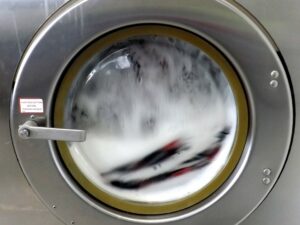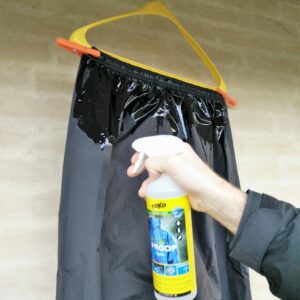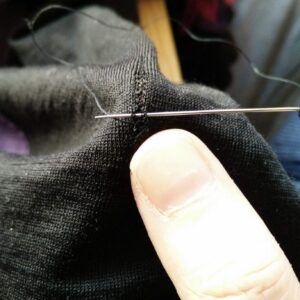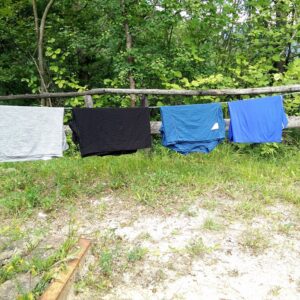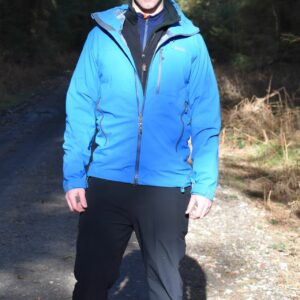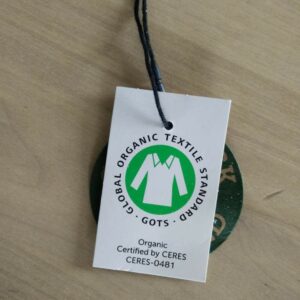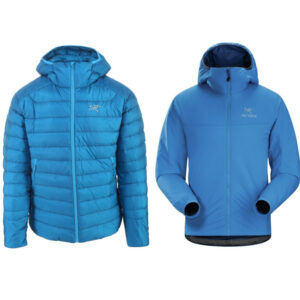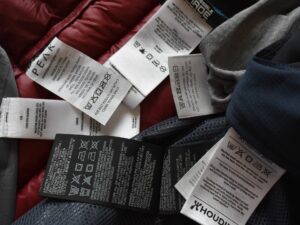
How to Wash Outdoor Clothing – washing tags can be annoying and confusing, but are vital for taking proper care of your precious apparel.
Outdoor clothing is performance wear, which is made to make you perform better in the great outdoors whether it is in the form of a moisture-wicking base layer, an insulating mid-layer or a shielding shell layer. However, as all other apparel, outdoor clothing will get dirty eventually – from within as well as from without. While you can prolong the time between washes by airing base layers or wiping dirt from jackets and pants, there comes a time where you will want to wash your outdoor clothing, by hand or in the machine.
This article is meant as a guide for how you should generally treat your outdoor clothing when you wash it. Towards the end, we have made a short sum-up of how to wash each type of outdoor clothing, but first we go over why it is important to avoid certain detergents and washing programs. Do, however, always follow the instructions on the garment in question or as described on the manufacturer’s website as there might for example be some differences on how to treat one rain jacket compared to another.
How to Wash Outdoor Clothing:
- Choosing the Right Detergent(s)
- Washing Machine vs Handwashing
- How to Wash Merino Wool Base Layers
- How to Wash Synthetic Base Layers and Mid-Layers (Fleece Jackets)
- How to Wash Down Jackets
- How to Wash DWR-Treated and Waterproof Clothing
What is Important:
Choosing the Right Detergent(s)
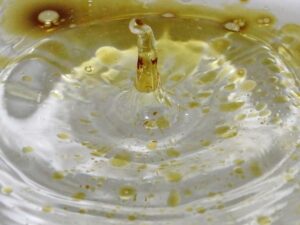
How to Wash Outdoor Clothing – you need some sort of soap to bind oil and water together. Photo by Jordi Martorell
Choosing the right detergent for washing outdoor clothing is key as you might otherwise end up deteriorating exactly the qualities of the garment you chose it for. Detergent or soap of some sort is necessary for washing any sort of clothing because water on its own can rarely dissolve and remove the grime and stains we expose our clothes to. That is because much grime (especially what comes from our bodies) is hydrophobic, meaning that it rejects or resists water. Think of how oil (hydrophobic) cannot mix with water. In whichever forms they come, all detergents or soaps have that in common that they have a chemical structure with both a hydrophobic and hydrophilic (literally “water-loving”) end, so they can connect to both water and the hydrophobic molecules in grime or stains. Thereby, the grime can be loosened from the fabric and flushed away with water.
These days, however, common washing detergents often have many additives such as enzymes or bleach in some form. This might help to get your everyday clothes of cotton or simple synthetics cleaner faster, but such additives can severely damage your outdoor clothing with repeated washing. Enzymes, for examples, work by attacking proteins as many stains are protein-based (e.g. egg, mud, dairy, blood and other bodily fluids). Therefore you should never use a run-of-the-mill washing detergent for your Merino wool clothing as the wool fibers are made of pure protein, and thus the enzymes literally eat away of the very material. The same goes for base layers made of silk or a blends of the two natural fibers. Common washing detergents are also somewhat problematic for DWR-treated and waterproof outerwear like rain jackets, softshell jackets and pants as the detergent will attack the molecules of the DWR- treatment and make it deteriorate faster. The same goes for DWR-treated down jackets, especially if the insulation is DWR-treated as well, i.e. hydrophobic down.
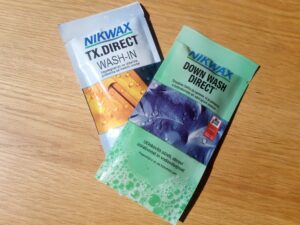
How to Wash Outdoor Clothing – the best is to use a detergent specifically made for one type of outdoor clothing
Common washing detergents can only come into consideration for use while washing synthetic base layers or fleece jackets, although you should make sure that the detergent contains no bleach. Bleach in most forms is worth steering clear off as it can damage both synthetic (polyester) and natural fibers like wool and silk. For washing outdoor clothing in the gentlest, yet most efficient manner it is best to choose a detergent which is specifically formulated for the particular type of fabric. Wool and silk detergents have been around for a long time, but many commercial brands now also offer detergents specifically aimed at rainwear (good for most DWR-treated outerwear) and sportswear. For detergents aimed at down jackets you might have to look to specialist brands like Nikwax, where the detergent is formulated to maintain or improve the water repellency of both the shell fabric and insulation. Nikwax offers detergents for basically every type of outdoor clothing and gear you have in mind.
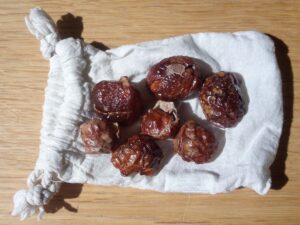
How to Wash Outdoor Clothing – soapberries are the best universal detergent for outdoor clothing due to the mild natural soap they contain
You might balk at the idea of having multiple detergents in your cabinet for washing your outdoor clothing, but it will help to make those key items perform better and last longer. For DWR-treated garments it will also help you to expand the time between having to re-waterproof them. If you are looking for a “one-detergent-suits-all” solution you might be tempted to try out soapberries, which are now widely available. They are completely natural and biodegradable, and quite inexpensive. In terms of washing outdoor clothing, the great advantage of soapberries is that they don’t contain any problematic additives, only a very mild and natural form of soap. You can read more about the use and benefits of soapberries here.
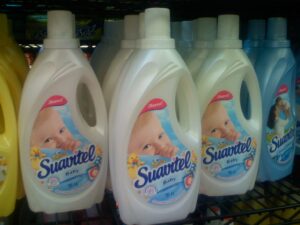
How to Wash Outdoor Clothing – avoid fabric softener of all kinds for your outdoor apparel. Photo by Dennis Yang.
An all-over no-no for washing outdoor clothing is fabric softener. As described on Wikipedia, fabric softeners work by coating the surface of fabrics with chemical compounds that make the threads “rise up” and thereby creating a softer and fluffier texture with less wrinkles and static electricity. This coating might be great for your towels and bed linen, but affects the moisture transportation and breathability of your outdoor clothing. Fabric softeners are generally also scented, and the perfumes (whether naturally or chemically derived) can cause allergic reactions – especially from base layers that you wear next to the skin. In addition, some of the ingredients in fabric softeners are hard for nature to break down and harm water living organisms. There is thus every reason to avoid fabric softener completely when washing your outdoor clothing, and perhaps altogether.
Washing Machine versus Handwashing

How to Wash Outdoor Clothing – hand-washing is the most gentle for your clothes, but can be time-consuming. Photo by Marco Verch.
Almost all clothes can be hand-washed with the exception of clothes with a “Dry Clean Only”-tag (which is quite rare for outdoor clothing). Hand-washing is surely to be preferred in many cases as it puts the least strain on your garments (unless you scrub or wring them vigorously) by avoiding the fast and repeated agitation and rubbing of zippers, buttons, snap fasteners, draw toggles and other hardware against the fabrics inside the machine. You can read a comprehensive guide on how to hand-wash clothing here. Again be mindful of the garment’s washing tag, avoid vigorous scrubbing and be sure to rinse out all of the detergent or soap you add initially before you hang the garment to dry. The down side of hand-washing, besides the extra time and energy spent, is exactly the drying time as the garment is soaking wet, and can only be wringed minimally without damaging it.
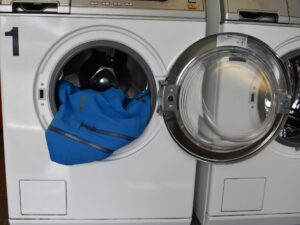
How to Wash Outdoor Clothing – front loader washing machines are the best for your clothing and wallet!
You can of course put the wet hand-washed garment in an old-fashioned centrifuge for clothing or a washing machine with a short spin cycle program (no water, no detergent), but then you might almost just as well just wash it in a machine. For most of us, washing outdoor clothing in a washing machine will be the usual choice for all but the most delicate items. However, not all washing machines are created equal. Front-loading washing machines handle garments more gently and thus enable a longer life-span of your outdoor clothing than top-loading washing machines (most common in the States, Canada and Australia). Front-loading machines also use less water and energy. That is not to say that you should ditch your top-loading machine as of this minute, but it might be worth keeping in mind if you are purchasing a new washing machine.
Many washing machines have special washing programs that could aid you in cleaning your outdoor clothing as gently as possible, such as a wool or delicate cycle using cold or cool water (≤30 ºC/ 86 ºF) with less spinning and less rotations per minute. If the garment is very soiled or has difficult stains, it will surely pay off to deal with it before washing it in the machine. Commercial stain-removers can be quite harsh and you can’t be sure how they will interact with the complex materials that outdoor clothing are often made of, unless it specifically says on the stain-remover’s label that it can be used for that particular type of material. Instead, colorless dish detergent might be your best solution for pre-treating a stain on a garment before washing it in the machine, but use it sparingly and remove any excess matter before closing the door to the drum.
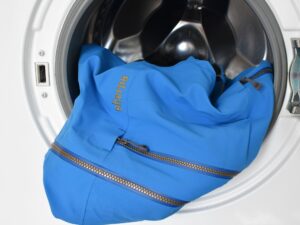
How to Wash Outdoor Clothing – consider washing a valuable jacket like the Sherpa Adventure Gear Makalu on its own
Finally, there is the matter of the quantity of the clothing in the washing machine. For everyday clothes and textiles washed at standard washing programs, you should wash with a full load for the sake of the environment (and your water and electricity bills). However, most outdoor clothing benefit from being washed at a gentle cycle, and the gentler the cycle, the less clothing should be washed at a time. This is because the reduced spinning will make it harder for the washing water to properly wash and rinse every inch of each garment if they are packed together in a bundle. If you are washing a precious shell jacket, you might even consider to wash it entirely on its own to prevent any other garments with zippers, buttons etc. to damage it during the spin cycle.
How to Wash Different Types of Outdoor Clothing:
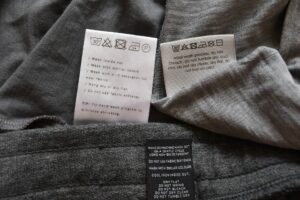
How to Wash Merino Wool – tags from Formal Friday, Falke Silk Wool and Isobaa 260 pants
How to Wash Merino Wool Base Layers
- Wash your Merino clothing carefully by hand (avoid pulling, wringing and scrubbing it), or wash it in a machine on a wool or delicates program with reduced spinning.
- Always utilize a special wool detergent or soapberries as a normal detergent (with enzymes) will eat away at the woolen protein fibers as described above.
- Air-dry on a line, unless the garment is soaking wet from hand-washing, in which case you should try to dry it somewhat flat to avoid the weight of the water pulling the garment out of shape.
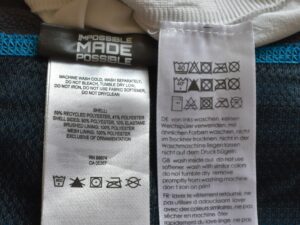
How to Wash Synthetic Base and Mid Layers – tags from Mountain Hardwear Monkeyman and Falke Cool base layer
How to Wash Synthetic Base Layers and Mid-Layers (Fleece Jackets)
- Synthetic base layers and fleece jackets can be washed at normal washing programs (up to 40 ºC/104 ºF) as the rapid spinning is not so problematic for this type of outdoor clothing. Close all zippers, tabs etc., nevertheless, to avoid damage. To decrease the amount of microplastic washed out of your synthetic outdoor clothing, you can wash it in a Guppyfriend wash bag.
- You don’t have to use any special detergent for washing synthetic base layers and fleece jackets, but do make sure it is without bleach.
- Air-dry on a line or dry it on the low setting in dry tumbler, if you absolutely must. It is better for the garments and the environment if you don’t.
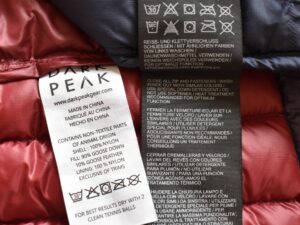
How to Wash Down Jackets – tags from Dark Peak Nessh and Jack Wolfskin JWP down jackets
How to Wash Down Jackets (and Down Sleeping Bags)
- Some down jackets are marked “Dry Clean Only”, but most can go in the washing machine. Some washing machines feature special down programs; if yours doesn’t, choose a not too warm program (30- 40ºC) with minimal spinning but a good rinse (for example wool). Close all zippers, tabs etc. to avoid damage.
- It’s best if you use a special down detergent, like NikWax or Granger’s to maintain or improve the water repellency of both the shell fabric and insulation without deteriorating other qualities.
- Carefully lay it out flat to dry on a drying rack, and turn around once in a while. When almost dry, put in a tumble dryer on the low setting with 2-3 tennis balls or woolen drier balls to maximize the loft of the down insulation. You can choose to skip either step of the drying process if you don’t have time or the equipment.
How to Wash DWR-Treated and Waterproof Clothing
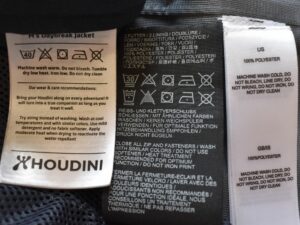
How to Wash DWR-Treated Clothing – tags from Houdini Daybreak, Jack Wolfskin JWP and Sherpa Adventure Gear Makalu shell jackets
- Some washing machines have special rainwear programs; otherwise, choose a colder program (30-40ºC) with a reduced spin cycle. Consider washing particularly valuable jackets on their own to avoid any damage from items rubbing against one another. Close all zippers, tabs etc. in any case.
- We advise you to use a special detergent for DWR-treated clothing to make sure the water-repellency deteriorates as little as possible. You can also choose a detergent which contains DWR to restore the water-resistance of the garment.
- It varies a lot how you should dry your shell layer, so do check the instructions. You can never go completely wrong with simply air-drying it, but some waterproof clothing needs moderate heat for the water repellant to be reactivated. In that case, the best is to use a tumble dryer on the low setting but some jackets can also be ironed at the lowest setting with a towel between the iron and the garment.
